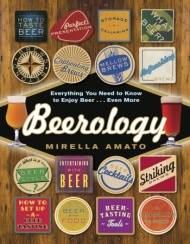 Beerology is like a great friend who holds you by the hand and leads you into the grown up world of beer. The author, Mirella Amato is a Master Cicerone, a beer version of a sommelier (there are less than 10 people holding the same title in the world). She knows her beers inside and out, and shares her knowledge in a very personable way. Amato guides you through different styles of beer, breaking down flavor profiles and even what to pair your beer with.
Beerology is like a great friend who holds you by the hand and leads you into the grown up world of beer. The author, Mirella Amato is a Master Cicerone, a beer version of a sommelier (there are less than 10 people holding the same title in the world). She knows her beers inside and out, and shares her knowledge in a very personable way. Amato guides you through different styles of beer, breaking down flavor profiles and even what to pair your beer with.
The book is easy to read, informative while being fun. Without getting mired in the details, this book explains how each variety is made and includes a short explanation of how the beer in question ends up with it’s particular flavor profile. This can really help you identify what you enjoy or dislike about particular styles so that you can seek out beers that you are more likely to enjoy. Your experience with beer might have been limited to one or two varieties or even a single brand, but after reading this book you may dare to try something new and might discover that you love something very different from your go-to beer.
There is great value in this book for the beer connoisseur as well, as it provides suggestions for brands and pairings that you may not have tried (or even heard of), and also vocabulary to describe what you are drinking. As a beer connoisseur and home-brewer, I found the food pairing ideas to be revelatory. I had never thought about beer in the same way as I had wine, as something to be enjoyed with food, and it was a great way to re-frame how I think about beer.
Some other takeaways:
The book helped me to understand why I love Belgians, Stouts and Porters, Sour Beers, Saisons, and why I dislike IPAs. Prior to reading this book, I believed that I disliked IPAs only because of how hoppy and bitter they tend to be. Belgians, Stouts, and Porters have more malt characteristics in them and fewer hops compared to IPAs.The book provided enlightenment for why the hops in my favorite beers did not bother me . I discovered through Amato’s explanation the difference between old world and new world hops. Old world hops are softer, less bitter and more about aromatics, my favorites being ones that taste like citrus and floral notes . New world hops are more aggressive and can be very bitter and are used for flavoring the beer. IPAS that are made with old world hops are ones that I may actually enjoy, rather than the new world style hop infused IPAs. Before reading this book, I did not know much about how beers age . There are some good suggestions for what beers to age and how to age them. Beers, like wine change with age, and some are designed to be able to be aged. The IPA I find overly hoppy today might taste really good to me in a year or two, because according to Amato, the hop notes fade with time and the malt flavors get intensified. After reading this book, I’m going to have to have to try some old world style IPAs and give them a shot.
Beerology is a fantastic read, and I highly recommend this book for anyone who is looking to expand their beer horizons. It is also great for someone who is trying to help a less experienced beer drinker explore the world of beer.
-JHC (Jennifer)

